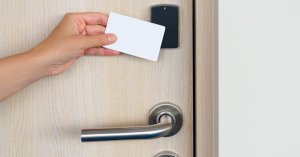Estimated reading time: 2 minutes
From a security perspective, typically patients aren’t allowed into rooms unless they’ve been directed into one by a healthcare professional. Rooms that double as labs, patient rooms, operating areas, and even pharmaceutical environments are a high-security realm and only certain employees will have access to those regions. This only makes sense because many sensitive materials or stored in these rooms and the average patient isn’t allowed to have access to those items; that’s just a fact. In this instance, access control systems are very beneficial for keeping the wrong people out and the right people in with their access credentials as seen fit. Healthcare professionals with the right level of access are able to easily integrate with back-end systems at all times, if something were to change or a manager would need to know when a specific employee entered a room or accessed a container of files.
 How does access control look in the healthcare environment? Swipe Card and Keypad readers are two of the most common entry points that are utilized in the healthcare industry including Hospitals, Administration buildings, Nursing Homes, Rehabilitation Centers, Surgical Centers, Imaging and Testing Centers, Blood Banks, and so many more facilities who harbor patients’ private medical information. Swipe Card Scanners are perfect for staff members who utilize their ID cards to move throughout the varying hallways and floors within facilities. Swipe cards can be easily attached to keychains and lanyards to be carried on a person at all times, so they are readily able to access rooms.
How does access control look in the healthcare environment? Swipe Card and Keypad readers are two of the most common entry points that are utilized in the healthcare industry including Hospitals, Administration buildings, Nursing Homes, Rehabilitation Centers, Surgical Centers, Imaging and Testing Centers, Blood Banks, and so many more facilities who harbor patients’ private medical information. Swipe Card Scanners are perfect for staff members who utilize their ID cards to move throughout the varying hallways and floors within facilities. Swipe cards can be easily attached to keychains and lanyards to be carried on a person at all times, so they are readily able to access rooms.
These security features act as additional padding for activities such cybersecurity to even visitor management. The core goal of every hospital and healthcare facility that is consumer-facing is to create an open environment that encourages healing and patient support, while also promoting a welcoming habitat for those coming to visit. At the same time that this type of facility is trying to convey an open environment, in a room right next to the lobby, nurses and lab technicians could be running intensive trials and tests to determine in contagious diseases are present, so you see it varies entirely. Rooms require different levels of restriction, take for example rooms that harbor narcotics, expensive equipment, or even sterile environments. That’s why access control is needed, encouraged, and ultimately required in this industry, for safety precautions.
Most importantly though, how do these organizations keep people safe and secure during a health crisis unlike one that we’ve all ever experienced before. In a time where touch is foreign and everyone has just spent the past year covering their face with a masks and coverings, to even always having hand sanitizer on their persons. For that whole purpose, low touch access control exists using QR codes as a credential so patients could check in for their appointment, follow a list of steps, entering information, to be granted access to appointment rooms, minimizing touch and eliminating the spread of any illness especially the COVID-19 virus. 
Utilizing an access control solution enables healthcare employees to break down the facility’s overwhelming collection of patients, visitors, and other participants into better manageable, role-based zones that work to come together into one appropriate and common platform. Access Control is key for balancing security challenges and maintaining a sense of normalcy in any environment, especially one as crucial for operations as a hospital would be.

